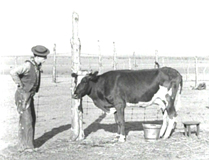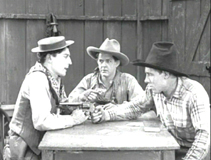|
Newest Reviews:
New Movies -
The Tunnel
V/H/S
The Tall Man
Mama Africa
Detention
Brake
Ted
Tomboy
Brownian Movement
Last Ride
[Rec]³: Genesis
Hara-Kiri: Death of a Samurai
Indie Game: The Movie
Abraham Lincoln: Vampire Hunter
Old Movies -
Touki Bouki: The Journey of the Hyena
Drums Along the Mohawk
The Chase
The Heiress
Show
People
The Strange Affair of Uncle Harry
Pitfall
Driftwood
Miracle Mile
The Great Flamarion
Dark Habits
Archives -
Recap: 2000,
2001, 2002,
2003, 2004
, 2005, 2006,
2007 , 2008
, 2009 ,
2010 , 2011 ,
2012
All reviews alphabetically
All reviews by star rating
All reviews by release year
Masterpieces
Screening Log
Links
FAQ
E-mail me
HOME
| |
Go West (Buster Keaton, 1925)
 Buster Keaton’s Go
West doesn’t quite compare to his best films such as The General or Seven Chances,
but is an admirable stab at the funny bone nonetheless. In this feature, as
usual, he plays the timid wimp, hopelessly inferior to every possible father
figure he encounters. Stars today complain about being typecast, but surely
silent film audiences had a firmer idea of what they wanted their celebrities to
be. Thankfully, the reason that Keaton was a star of the silent screen was
because he was able to deliver so consistently using the narrow persona that he
fashioned. Famously called “Stone Face” due to his lack of facial
expressiveness (a trait that actually makes his characters all the more
endearing, since they’re so undauntable), the actor sends up that facet of his
on-screen personality here in a comical scene in which he’s asked to smile at
gunpoint. At that point has to manipulate his face into a slight smirk by using
his fingertips. It’s a great joke, but it’s one that is a lot funnier for
those who are familiar with Keaton’s other films, and the solemnity that
dominates his performances. As such, Go
West is probably not the best place in his oeuvre to start. Buster Keaton’s Go
West doesn’t quite compare to his best films such as The General or Seven Chances,
but is an admirable stab at the funny bone nonetheless. In this feature, as
usual, he plays the timid wimp, hopelessly inferior to every possible father
figure he encounters. Stars today complain about being typecast, but surely
silent film audiences had a firmer idea of what they wanted their celebrities to
be. Thankfully, the reason that Keaton was a star of the silent screen was
because he was able to deliver so consistently using the narrow persona that he
fashioned. Famously called “Stone Face” due to his lack of facial
expressiveness (a trait that actually makes his characters all the more
endearing, since they’re so undauntable), the actor sends up that facet of his
on-screen personality here in a comical scene in which he’s asked to smile at
gunpoint. At that point has to manipulate his face into a slight smirk by using
his fingertips. It’s a great joke, but it’s one that is a lot funnier for
those who are familiar with Keaton’s other films, and the solemnity that
dominates his performances. As such, Go
West is probably not the best place in his oeuvre to start.
 Go
West’s plot, like that of most silent comedies, is rather simple, but it
allows for numerous opportunities for the audience to snicker at Keaton’s
put-on inadequacy. After a hilariously brief, abortive attempt at city life,
Keaton (credited here as “Friendless”) heads to the Wild West, and blunders
his way into a job as a farmhand. The bulk of the film follows Keaton as he
naively goes about performing his tasks as a cowboy. Essentially, the film is
most easily understandable to modern audiences as a live-action cartoon, or
perhaps more accurately as an antecedent for many of the cartoons that would
Keaton’s lead. Even though the it culminates with a wild, 1000-head stampede
through the streets of Los Angeles, pathos trumps spectacle in Go
West, which gives Keaton a tiny pistol to compete with the other cowboys’
big guns and a wispy physical presence that begs one to scoff. Vaguely asexual,
with a charming cow named Brown Eyes as his romantic lead, Keaton’s character
is recognizable as a real person, but one that is easy to underestimate. Go
West is a large achievement, however, and the small presence at its center
tends to ground things. The scope of the comedy, which takes Keaton from coast
to coast in search of laughs is undeniably impressive, but there’s something a
lot more precious happening when Friendless and Brown Eyes’ eyes connect. Go
West’s plot, like that of most silent comedies, is rather simple, but it
allows for numerous opportunities for the audience to snicker at Keaton’s
put-on inadequacy. After a hilariously brief, abortive attempt at city life,
Keaton (credited here as “Friendless”) heads to the Wild West, and blunders
his way into a job as a farmhand. The bulk of the film follows Keaton as he
naively goes about performing his tasks as a cowboy. Essentially, the film is
most easily understandable to modern audiences as a live-action cartoon, or
perhaps more accurately as an antecedent for many of the cartoons that would
Keaton’s lead. Even though the it culminates with a wild, 1000-head stampede
through the streets of Los Angeles, pathos trumps spectacle in Go
West, which gives Keaton a tiny pistol to compete with the other cowboys’
big guns and a wispy physical presence that begs one to scoff. Vaguely asexual,
with a charming cow named Brown Eyes as his romantic lead, Keaton’s character
is recognizable as a real person, but one that is easy to underestimate. Go
West is a large achievement, however, and the small presence at its center
tends to ground things. The scope of the comedy, which takes Keaton from coast
to coast in search of laughs is undeniably impressive, but there’s something a
lot more precious happening when Friendless and Brown Eyes’ eyes connect.
69
08-05-03
Jeremy Heilman
|